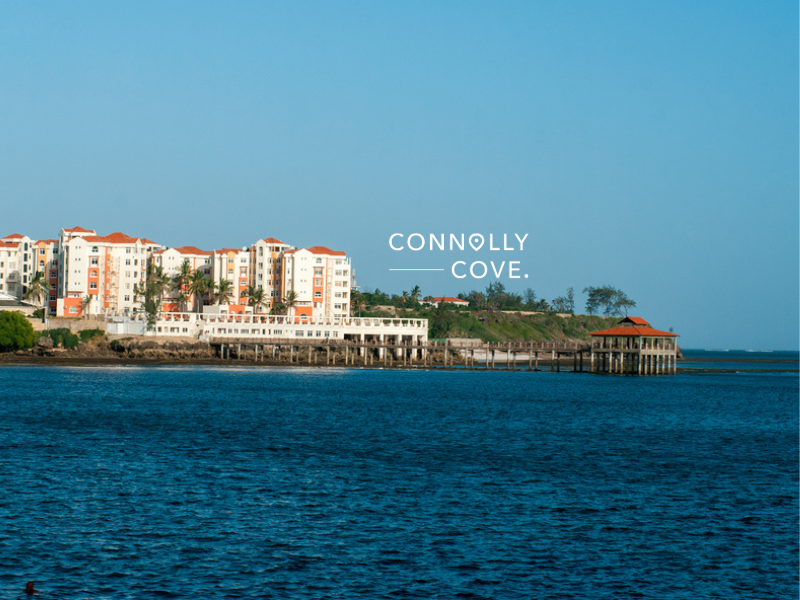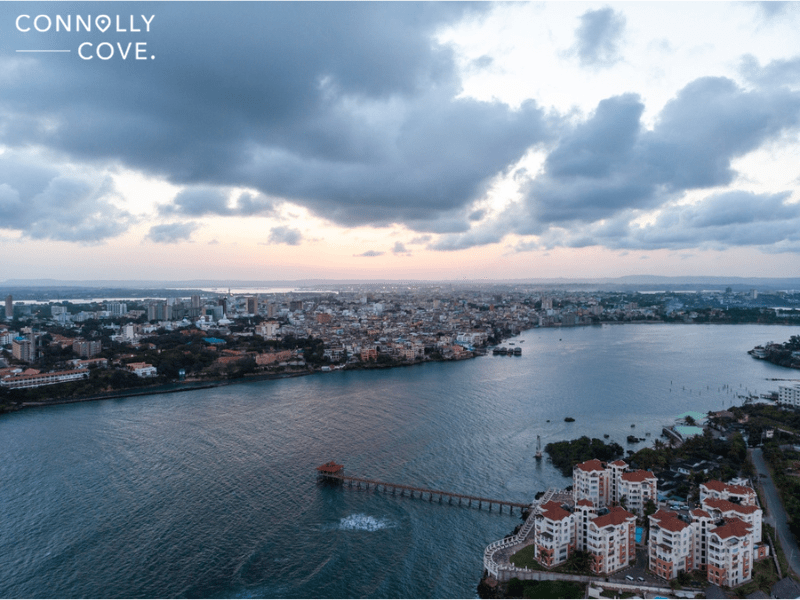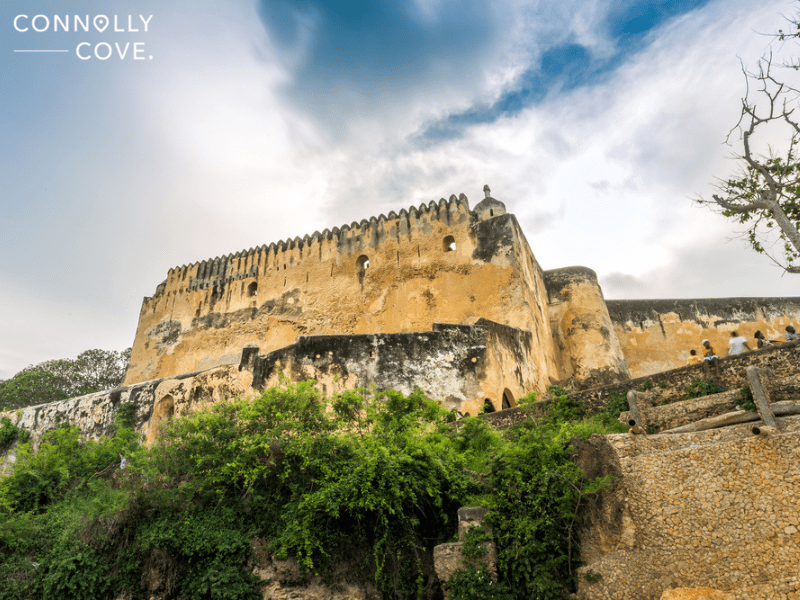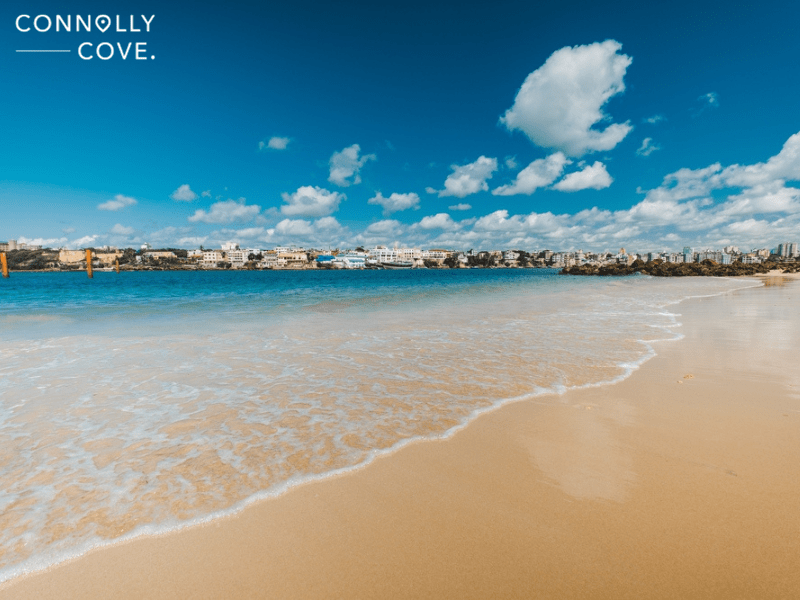Mombasa: The White and Blue Coastal Jewel of Kenya

Updated On: May 07, 2024 by Maha Yassin
Ah, Mombasa! Get ready to dive into a vibrant tapestry of cultures, sun-kissed beaches, and ancient secrets. This Kenyan gem, nestled on the Indian Ocean coast, beckons with its irresistible charm.
Mombasa is more than a destination; it’s an experience. It’s the sun-kissed sand warming your skin, the whispers of history echoing in ancient stones, and the vibrant pulse of life pulsating through its heart. So pack your sense of adventure, sunscreen, and a curious spirit, and let Mombasa paint your Kenyan adventure with unforgettable strokes of vibrant colour.
Where is Mombasa?

Mombasa is nestled on the southeastern coast of Kenya, along the vast expanse of the Indian Ocean. It sits proudly on Mombasa Island, away from the mainland by Tudor Creek and Kilindini Harbour. The city sprawls beyond the island, connecting to the mainland through bridges, ferries, and the Kenya-Uganda Railway.
Mombasa is approximately 440 kilometres southeast of Nairobi, Kenya’s capital city. It is Ideally situated for exploring other coastal gems like Malindi and Watamu. Finally, Mombasa is a beautiful gateway to East Africa’s captivating wildlife experiences, with national parks like Tsavo East and West within reach.
A Brief History of Mombasa, Kenya
Mombasa, the vibrant coastal jewel of Kenya, boasts a history as rich and diverse as the Swahili spices that fill its bustling markets. Nestled on an island in the Indian Ocean, Mombasa has witnessed centuries of empires rise and fall, leaving a captivating tapestry of cultures and architectural wonders.
Ancient Swahili Beginnings
Our journey begins around the 10th century AD, when the Swahili people, a blend of Bantu and Arab cultures, established settlements along the East African coast. Mombasa thrived as a key trading port, its strategic location linking the African interior with the bustling markets of Arabia, Persia, and India. Merchants traded gold, ivory, and slaves, while dhows, traditional wooden sailing vessels, crisscrossed the turquoise waters, carrying exotic goods and cultural influences.
Portuguese Arrival and the Rise of Fort Jesus

In 1498, Portuguese explorer Vasco da Gama landed in Mombasa, marking the arrival of European powers on the East African coast. The Portuguese, eager to control the lucrative spice trade, sought to dominate the region. In 1593, they constructed Fort Jesus, a formidable stone fortress overlooking the harbour. The fort’s imposing presence symbolised Portuguese power and became a silent witness to the city’s turbulent history.
Omani Rule and Cultural Flourishing
After nearly a century of Portuguese rule, the Omani Arabs seized control of Mombasa in 1698. Under their reign, the city flourished as a centre of Islamic scholarship and cultural exchange. Grand mosques like the Masjid Pepo la Mvita and intricate tombs like the Kirwa ruins are a testament to this artistic and religious expression era.
British Colonisation and the Birth of Modern Mombasa
In the late 19th century, the British Empire set its sights on East Africa. In 1895, they leased Mombasa from the Sultan of Zanzibar, establishing it as the capital of the British East Africa Protectorate. The British era saw the development of modern infrastructure, including the iconic Mombasa-Nairobi railway, which transformed the city into a vital economic hub.
Independence and a New Chapter
Kenya gained independence from the British Empire in 1963, and Mombasa embarked on a new chapter. It remains a key port city, a bustling tourist destination, and a vibrant cultural melting pot. Visitors can wander through the labyrinthine alleys of the Old Town, savour the flavours of Swahili cuisine, and bask on the sun-kissed beaches, all while experiencing the echoes of a rich and fascinating past.
Mombasa’s story is far from over. As Kenya continues to evolve, so too will this dynamic city. One thing is certain: Mombasa’s future promises to be as captivating and diverse as its past. Mombasa awaits, ready to share its fascinating history and vibrant culture with you.
Planning a Trip to The White and Blue City

Planning a trip to Mombasa, Kenya, is like diving into a treasure chest overflowing with dazzling beaches, ancient secrets, and a vibrant cultural kaleidoscope. Whether you’re a sun-seeker, history buff, or adventurer, Mombasa has something for everyone.
The Best Time to Visit Mombasa
When picking the perfect time for your Mombasa adventure, it all boils down to what you yearn for most from your trip. Here’s a breakdown of the best seasons and what they offer:
High Season (July-October & January-February): Drench yourself in the sunshine! These months are ideal for basking on golden beaches like Nyali or Bamburi. The ocean sparkles with turquoise hues, perfect for swimming, snorkelling, and soaking up the vitamin D.
Shoulder Seasons (May-June & November-December): Consider venturing outside the peak months for slightly lower prices and smaller crowds. While May to June might occasionally showers, November to December brings warmer temperatures and a short rainy season.
Dry Seasons (July-October & January-February): The dry seasons are prime time for safaris! Head inland to Tsavo East or West National Parks and witness the incredible diversity of African wildlife. Clear skies and sparse vegetation give you a higher chance of spotting iconic creatures like lions, elephants, zebras, and giraffes.
Green Season (March-May): If you prefer lush landscapes and don’t mind the occasional downpour, March to May might be your ideal safari window. The parks are less crowded, and the thicker vegetation creates a dramatic backdrop for your wildlife encounters.
Choosing the ideal time for your Mombasa trip depends on your priorities. While peak seasons offer sunshine and ideal beach conditions, shoulder seasons are cheaper and potentially less crowded. For wildlife enthusiasts, dry seasons are prime safari time, while cultural explorers can enjoy Mombasa’s charm year-round.
Accommodations in the Coastal City
From luxurious beachfront havens to charming guesthouses steeped in history, Mombasa offers a delightful spectrum of places to rest your head after exploring sun-kissed beaches and vibrant spice markets. Whatever your budget is, Mombasa has the perfect accommodations for you!
Beach Bliss
- Sarova Whitesands Beach Resort & Spa: Pamper yourself at this sprawling beachfront resort. Imagine sinking into infinity pools overlooking the turquoise ocean, indulging in spa treatments, and savouring fresh seafood at oceanfront restaurants.
- Serena Beach Resort & Spa: Experience Swahili village vibes at this beachfront gem. Lush gardens, traditional bandas (huts), and a vibrant kids’ club make it ideal for families. Dive into water sports, enjoy live entertainment, or unwind at the luxurious spa.
Budget-Friendly
- The Maji Beach Boutique Hotel: This chic boutique hotel offers a stylish yet affordable beach escape. Relax by the pool, enjoy delicious pizzas, and soak up the laid-back vibes in the cosy bar.
- Diani Sea Breeze Resort: Nestled on Diani Beach, known for its pristine white sand and cool waters, this resort offers comfortable cottages and apartments at pocket-friendly prices. Enjoy water sports, delicious Swahili cuisine, and breathtaking sunrises over the Indian Ocean.
Historic Enchantment
- Mombasa Backpackers: Immerse yourself in the Old Town’s rich history at this charming hostel. Sleep in restored Swahili houses, mingle with fellow travellers in the courtyard and explore the labyrinthine alleys and bustling markets at your doorstep.
- Alfajiri Sail Cottages: Experience the tranquillity of Tudor Creek at these unique cottages built on stilts. Wake up to stunning views of the mangroves, kayak through the serene waters, and enjoy Swahili dinners on the rooftop terrace.
Bonus Tip: Consider renting a private villa! Mombasa offers an array of stunning villas with private pools, ideal for families or groups seeking a luxurious and secluded retreat.
Mombasa’s Mouthwatering Cuisine
Mombasa’s cuisine is a vibrant tapestry woven from the threads of its multicultural history. Swahili flavours mingle with Arabic influences, Indian spices dance with Portuguese touches, and fresh seafood whispers tales of the Indian Ocean. Prepare to tantalise your taste buds with exotic aromas and delectable dishes.
Instead of telling you where to eat, we’ll tell you about the best Mombasa dishes. Whether you eat them in a fancy restaurant or buy them from a street vendor, these dishes are a must-try in the White and Blue City.
- Mchuzi: Rich stews simmered with coconut milk, vegetables, and your choice of protein, from chicken and beef to seafood and lentils.
- Pilau: Fragrant rice dish infused with spices and often served with meat or vegetables.
- Samosas: Savory, crispy turnovers filled with spiced potatoes or meat, perfect for snacking.
- Mandazi: Fluffy Swahili doughnuts, ideal for dipping in chai or coffee.
- Nyama Choma: Flame-grilled skewers of meat or seafood, a must-try for barbecue lovers.
- Octopus Curry: A Swahili speciality with a rich and flavorful coconut milk base.
- Chapatis: Soft flatbreads perfect for scooping up curries and stews.
- Samosas: Spiced potato or meat-filled pastries similar to their Swahili cousins.
- Halwa: Rich, dense fudge-like confection made with nuts, spices, and honey.
- Maembe: Fresh mangoes, a juicy and refreshing treat.
The Best Tourist Attractions in Mombasa
Picking a single “best” attraction in Mombasa is like choosing a favourite star in the sky – each one shines uniquely! However, depending on your interests, here are a few contenders for the top spot:
For Beach Lovers

- Nyali Beach: Picture yourself sinking into the soft, golden sand of Nyali Beach, where gentle waves whisper secrets of Swahili sultans and the turquoise ocean stretches like a shimmering invitation. Soak up the sun, build sandcastles, or try watersports like snorkelling and kayaking.
- Diani Beach: Venture south of Mombasa to Diani Beach, a paradise of pristine white sand and calm waters. Stroll along the shore, collect seashells, or indulge in pampering spa treatments at a beachfront resort.
For History Buffs
- Fort Jesus: Step back in time at Fort Jesus, a 16th-century Portuguese fort that stands sentinel to the city’s turbulent past. Explore the ramparts, tunnels, and cannons, and imagine the battles and conquests that unfolded within its walls.
- Old Town: Get lost in the labyrinthine alleys of Mombasa Old Town, where intricately carved wooden doors whisper tales of ancient spice traders and fragrant aromas tantalise your senses. Visit the bustling markets, haggle for souvenirs, and soak in the vibrant vibes of this UNESCO World Heritage Site.
For Nature Wanderers
- Haller Park: Discover a haven for wildlife at Haller Park, a sanctuary transformed from a barren quarry into a flourishing ecosystem. See giraffes roaming freely, hippos wallowing in the mud, and crocodiles basking in the sun. Learn about conservation efforts and witness the park’s inspiring story of environmental rehabilitation.
- Tsavo East National Park: Embark on an unforgettable safari adventure in Tsavo East National Park, home to the legendary “man-eating lions” and a staggering array of African wildlife. As you traverse the vast savannah plains, keep your eyes peeled for lions, elephants, zebras, giraffes, and cheetahs.
Ultimately, the best of Mombasa speaks to your soul the most. Whether you crave sun-kissed beaches, traditional African dishes, or an adventure through history, Mombasa has something for everyone. So, if you’re seeking a new experience in a new place that is seriously underrated, pack your bags and get on the next flight to Mombasa, Kenya!
FAQs
How do I get to Mombasa?
Moi International Airport (MBA) is the main gateway, with flights from various international destinations. You can also reach Mombasa by train from Nairobi or ferry from Lamu Island.
Do I need a visa to visit Mombasa?
Most nationalities require a visa upon arrival. Apply online or at your nearest Kenyan embassy beforehand.
What currency is used in Mombasa?
The Kenyan shilling (KES) is the official currency. You can exchange currency at the airport, banks, or authorized forex bureaus. ATMs are widely available.
What should I wear in Mombasa?
Pack light, comfortable clothing like cotton t-shirts, shorts, and sundresses. Swimwear is essential for beach activities. Bring a hat, sunglasses, and sunscreen for sun protection. Be respectful by covering up when visiting religious sites or local villages.
Can I bargain in Mombasa?
Bargaining is expected in markets and with street vendors. Be polite and friendly, and start with a significantly lower price than the initial offer.






